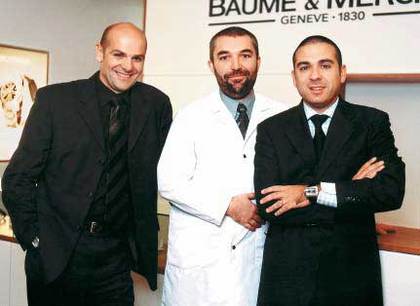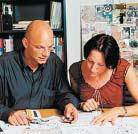Tribune des Arts - No316 - November 2003

Daniel Braillard, Industrial Manager, Pascal Moulins, Production Manager, and Michel Nieto, Director of Baume & Mercier. DR
Watchmakers, restorers, case makers, and so forth; every skill is represented across an area of 1,200 m2. It also has “ZAC” (controlled atmosphere zone) workshops where special coats and shoes have to be worn to prevent the slightest grain of dust from penetrating the movements or dials.
A creative process based on trust
The creative work meanwhile is all carried out at the company's headquarters in Geneva by a team of designers working in close co-operation with their marketing and technology development colleagues to take into account the numerous technical and commercial constraints immediately. Indeed, the motto of the Baume brothers is still very much present today at each stage of the Baume & Mercier watchmaking process: “Overlook nothing, make watches only of the highest quality”.
“Even if we don't manufacture each component part of our watches, we have managed to achieve total control of the entire process,explains Michel Nieto. “Partly by only ever approaching partners who are the best in their field and partly by working with them in a totally transparent and honest way, anticipating problems and being demanding, but loyal too. This reciprocal trust also gives us enormous flexibility which enables us to respond rapidly to different market reactions”.
No room for compromise
At Baume & Mercier, design is by far the most important step in the manufacture of a watch: “We have to think of everything, analyse each detail, be constantly vigilant before embarking on production. A watch that is badly designed at the outset ultimately ends up costing very dear. I therefore prefer to stop a project once we realise that it's started off badly rather than release a model anyway that's the result of a bad compromise, technically or aesthetically. Consequently, we always compare several different avenues when investigating each new creation”.

The industrial engineering bureau comprises three construction designers: Sandra Winter (working here with Alexandre Peraldi), Jérôme Ducrey and Cédric de Stéfani. DR


Despite drawerfuls of amazing projects, Baume & Mercier focuses on the three mainstays of the brand: “Linea”, “Capeland” and “Hampton”, with the necessary addition of course of the iconic “Riviera”. Moreover, the brand only uses movements of proven reliability, whether automatic (35% to 40%) or quartz (60% to 65%), and only accepts the highest quality when it comes to watch exteriors. It has thus been able to offer its customers an optimum after-sales service.Indeed, although Baume & Mercier offers a very broad guarantee, assuring the availability of all spare parts for watches manufactured in the past 25 years, the possibility of repairing any Baume & Mercier watch, whatever its age (the firm was founded in 1830), and twelve repair centres across the world, the after-sales service is devoted above all to battery changes or the maintenance of mechanical movements. This goes to show the outstanding quality of its watches, always. The working method of Baume & Mercier is therefore akin to the great tradition of Genevan horologists of the 18th and 19th Centuries.



The creation team: Sara Sandmeier, Alexandre Peraldi and Sabine Rochat. DR
In the great Genevan tradition
At the time, most movement manufacturers were based in the Joux Valley. They would come several times a month, on foot, to deliver the fruits of their labour to the large Genevan firms which would adorn them in gold and enamel, precious stones or pearls, before selling them around the world. The Genevans would produce the design, do the drawings, analyse the market and then entrust the creation of their watches to specialists, outstanding enamelling artists such as Liotard, goldsmiths, jewellers, watchmakers - all self-employed - who formed the famous “Fabrique”, made up of hundreds of cabinotiers. They would then set off for Russia, Europe, Turkey, and as far away as China, to sell their creations. Baume & Mercier does exactly the same today, still turning to the best sub-contractors to produce the impressive number of watches manufactured and sold by the firm each year. How many? The exact figure has not been disclosed but it is in the region of several tens or indeed hundreds of thousands.







